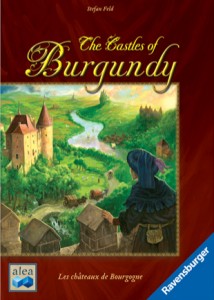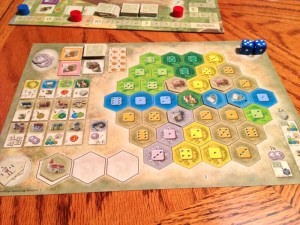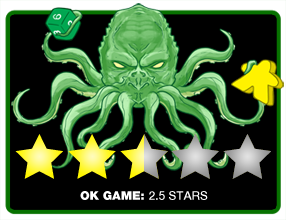 The Castles of Burgundy is a relatively new game by designer Stefan Feld (Macao, In the Year of the Dragon). It has gained a lot of popularity in the time since its release in 2011. The Castles of Burgundy is a dice action-taking game where players are tasked with developing their small princedom in Medieval France. There is no mistaking that The Castes of Burgundy is a euro game. The theme is not very deep and the goal of the players is to try and collect the most victory points possible. The game plays in about 90 minutes and can accommodate 2-4 players.
The Castles of Burgundy is a relatively new game by designer Stefan Feld (Macao, In the Year of the Dragon). It has gained a lot of popularity in the time since its release in 2011. The Castles of Burgundy is a dice action-taking game where players are tasked with developing their small princedom in Medieval France. There is no mistaking that The Castes of Burgundy is a euro game. The theme is not very deep and the goal of the players is to try and collect the most victory points possible. The game plays in about 90 minutes and can accommodate 2-4 players.
Game Overview:

In The Castles of Burgundy, players will take turns over a set number of rounds, each getting two actions on their turn. Each player will have a play mat that encompasses the estate they are building and their tile storage. The players share a central board that serves as the supply and victory point track.
The game turns are somewhat simple in The Castles of Burgundy. At the start of each round, each player rolls 2 6-sided dice. The numbers that come up will let the player know which numbered supply they are allowed to pull resources from that turn. Each die counts as 1 action. After each player has used both of their dice, their turn ends and the next round begins.
The game is actually divided up into 5 phases, each of which will consist of 5 rounds. At the end of the 5th phase, the game is over and the winner is the one with the most victory points. Simple enough.
Components:
I was somewhat disappointed with the components of this game. While the price point isn’t very high, the game still feels a little cheaply made. For most people, the main complaint with The Castles of Burgundy is the player mats. They seem to be made of a light card stock, rather than standard cardboard. They feel quite flimsily and seem like they could tear or bend fairly easily. The artwork for this game is also somewhat bland. The colors have a little bit of low-saturation feel to them and the artwork is not particularly impressive. I would like to note that you do get a lot of tokens with this game. There are about 164 hex tokens that will be used in the game, a handful of dice and some other miscellaneous tokens. This does make setup a bit of a chore, as there is a lot to keep organized. I’d recommend one of those plano storage boxes if you are going to play this game a lot.
How to Play:

As mentioned earlier, the game consists of 5 phases, each with 5 rounds in them. You start off each phase with the setup. This goes by fairly quickly, doing the usual placing of tiles and restocking goods. Once the board is ready, the new round is ready to begin.
Each round is carried out in the same manner. First, each player will roll their 2 dice with the starting player rolling an extra white die. That extra die is used to stock a bonus good on the board, then it is ignored for the rest of the round.
On a players turn, they can use their 2 dice results as an action (one action per die). Their possible actions are:
• Take a 6-sided tile from the game board. The tile’s numbered location must match the die result being used.
• Add a 6-side title to your estate. Once tiles are taking from the central board, they go into a holding pattern on your play mat until you use an action to play them in your estate. There are specific rules for which tiles can be played where, and a player must be conscious of that when making their decisions. When a player does play a tile on their estate, they are rewarded with a bonus, specific to the tile played. Those bonuses range from extra actions to collecting free goods to scoring victory points. This does provide for some intersting strategic decisions to make during the game.
• Sell Goods. A player may sell goods of one type from the storage area on his play mat. Goods are collected usually as a bonus from playing specific 6-sided tiles onto his estate. Selling goods is how players earn victory points.
• Take worker tiles. A player can grab 2 worker tiles from the supply. Worker tiles are helpful because they allow a player to alter the rolls of his action dice. Usually + or – 1 number. Helpful if you rolled a 5 and you really wanted a 6.
Turns proceed in this manner until the end of the 5th phase, where each player totals up his victory points and the winner is declared.

Game Experience:
I really wanted to like The Castles of Burgundy. I had heard nothing but glowing reviews on the game, which is what made me decide to get a copy. However, while I think I will be in the minority on this opinion, I was left a little disappointed with this game.
The Castles of Burgundy isn’t a bad game by any stretch, but it’s also was not a very exciting one. Turns will usually be slow and involve a lot of thinking. Since each tile has its own benefits when played, there are a lot of decisions to be made with each of your limited actions. If someone grabs the tile that you were basing your whole turn on, you have to start over thinking what to do, it can really add to the downtime. If you have a group that’s prone to “analysis paralysis”, than this game could be a nightmare for your group.

Player interaction is also not a very big part of this game, other than another player taking that tile you had your eye on. You’ll do your rolls, take your action and so will the other players. This is especially noticeable when you have more then 2 players. Turns become more complex, as you have more tile options and there are more players to change your turn strategy as they take your tiles. I felt like there was a lot of waiting for me turn to come around. The game plays more like Chess, in that turns are quiet and the action is minimal.
As with many euro games, the theme is somewhat dry. While you are supposed to be building your estate in the Burgundy region of France, it doesn’t really feel like it. The bland components really don’t help sell the theme and this game could be set in any rural region. If this game appeals to you, you will be buying it for the mechanics, not the theme.
Learning the actual game play isn’t very hard at least. With only 4 options for actions on your turn, its fairly easy to pick up. The harder part will be knowing what every tile does. At the start of every round, we had to go around and say what each tile did, because they are only labeled with a symbol. Have a cheat sheet handy is very helpful.
Even with all that sad, The Castles of Burgundy isn’t a bad game. The game play feels quit balanced and some of the mechanics are pretty interesting. I like the idea of rolling dice and basing actions on what you roll. The workers allowing you to “fudge” your die rolls was also a great idea.
This can easily be considered one of those games that’s simple to learn, but difficult to master. I can see people who like deep strategy really enjoying this game. However, for us, it just wasn’t enough fun for the 1.5 hours it took us to play.
Final Thoughts:
So if you haven’t figured it out by now, The Castles of Burgundy didn’t quite meet my expectations. I did enjoy some of the game mechanics and really wish I had liked this game more. However, at the end of the day, it just didn’t scratch the right itch for us. We finished the game and said “OK”, and that was it. We cleaned up and put the game back on the shelf. The ending wasn’t very exciting and the turns had just a bit too much downtime for a Euro game. We also didn’t really get that social connection you can have with a tabletop game. The lack of interaction and slow game play will probably cause this one to stay on the shelf, more often then not.
I think there will be people out there that will really enjoy this game, but I think it needs the right group of people. If you are looking for a deep theme, good interaction or even high quality components, this will leave you high and dry. However, if you are looking for a euro game with some interesting mechanics and some thought provoking strategy, than The Castles of Burgundy might be right up your alley.
If you are interested in getting a copy for yourself, it’s about $30
Final Score: 2.5 Stars – Some unique mechanics and interested strategy, however bland components, theme and low player interaction left us wanting more in a euro game.
 Hits:
Hits:
• Interesting dice action mechanic
• Deep, strategic game play
Misses:
• Bland artwork and sub par components
• Low player interaction
• Bad for people with “Analysis Paralysis”





















